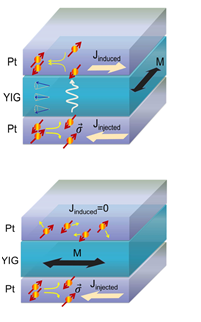New Spin Current-Based Memory Devices and Switches
Background
There is potential for devices capable of utilizing spin current to be vastly more powerful than existing electronics while also reducing the amount of electricity used in future electronic devices. As a result, there exists an ongoing need for improved systems and methods for manipulating spin in solid state devices. A breakthrough in manipulating spin would greatly increase data storage capacity and greatly reduce the power consumption in electronics devices
Brief Description
Prof. Jing Shi and his colleagues from the University of California, Riverside have developed two new applications to utilize spin current in electronic devices.
The first is a pure spin current switch that allows for the manipulation of pure spin current in electronic devices by allowing the user to switch between an “on” and “off” state. The device includes a first metal layer, a magnetic insulator layer, and a second metal layer. This technology controls the flow of information by switching the direction of magnetization of the middle layer. Since spin current does not require electricity, the spin current switch holds an innovative promise for the future of the way electronic devices channel current.
The second is a non-volatile random access memory (RAM) device capable of using spin current to reduce electricity consumption. The technology can transmit information through electrical insulators, where the flow of information can be switched “off” by applying a magnetic field. The “on” and “off” states are two non-volatile memory states that can be stored as the magnetization direction of the magnetic insulator layer. This technology holds promise for a new generation of RAM technology that is not limited by memory bottleneck.
Fig. 1: A schematic illustration of a spin current valve. Top: The switch in the "on" position.
Bottom: The switch in the "off" position.
Suggested uses
- Devices that have increased non-volatile Random Access Memory and require less energy to operate
- An on/off switch that is modulated by spin current propagation within a magnetic field
Patent Status
| Country | Type | Number | Dated | Case |
| United States Of America | Issued Patent | 9,929,338 | 03/27/2018 | 2016-187 |
Related Materials
Contact
- Venkata S. Krishnamurty
- venkata.krishnamurty@ucr.edu
- tel: View Phone Number.
Other Information
Keywords
magnetic current, spin current, RAM, switch, memory, spintronics
